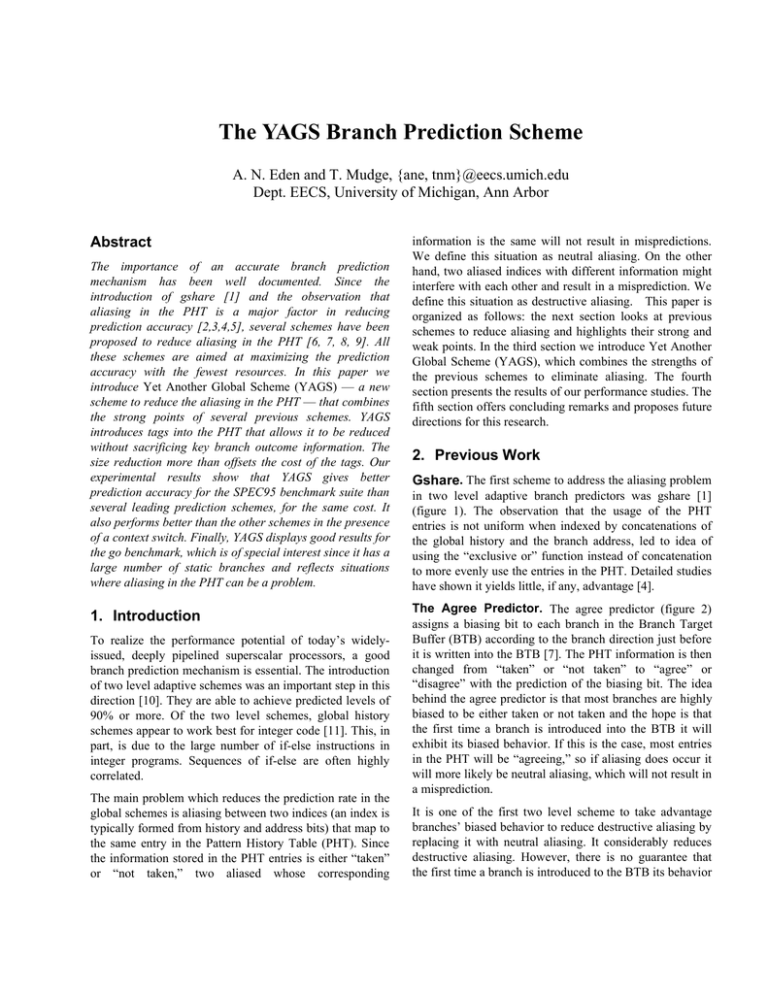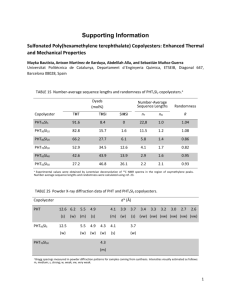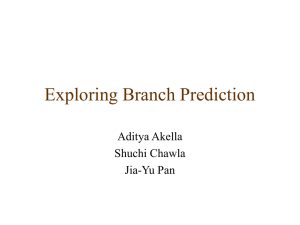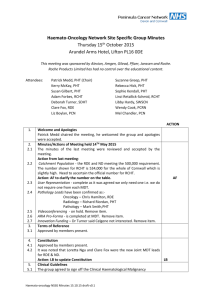Abstract
advertisement

The YAGS Branch Prediction Scheme
A. N. Eden and T. Mudge, {ane, tnm}@eecs.umich.edu
Dept. EECS, University of Michigan, Ann Arbor
Abstract
The importance of an accurate branch prediction
mechanism has been well documented. Since the
introduction of gshare [1] and the observation that
aliasing in the PHT is a major factor in reducing
prediction accuracy [2,3,4,5], several schemes have been
proposed to reduce aliasing in the PHT [6, 7, 8, 9]. All
these schemes are aimed at maximizing the prediction
accuracy with the fewest resources. In this paper we
introduce Yet Another Global Scheme (YAGS) — a new
scheme to reduce the aliasing in the PHT — that combines
the strong points of several previous schemes. YAGS
introduces tags into the PHT that allows it to be reduced
without sacrificing key branch outcome information. The
size reduction more than offsets the cost of the tags. Our
experimental results show that YAGS gives better
prediction accuracy for the SPEC95 benchmark suite than
several leading prediction schemes, for the same cost. It
also performs better than the other schemes in the presence
of a context switch. Finally, YAGS displays good results for
the go benchmark, which is of special interest since it has a
large number of static branches and reflects situations
where aliasing in the PHT can be a problem.
1. Introduction
To realize the performance potential of today’s widelyissued, deeply pipelined superscalar processors, a good
branch prediction mechanism is essential. The introduction
of two level adaptive schemes was an important step in this
direction [10]. They are able to achieve predicted levels of
90% or more. Of the two level schemes, global history
schemes appear to work best for integer code [11]. This, in
part, is due to the large number of if-else instructions in
integer programs. Sequences of if-else are often highly
correlated.
The main problem which reduces the prediction rate in the
global schemes is aliasing between two indices (an index is
typically formed from history and address bits) that map to
the same entry in the Pattern History Table (PHT). Since
the information stored in the PHT entries is either “taken”
or “not taken,” two aliased whose corresponding
information is the same will not result in mispredictions.
We define this situation as neutral aliasing. On the other
hand, two aliased indices with different information might
interfere with each other and result in a misprediction. We
define this situation as destructive aliasing. This paper is
organized as follows: the next section looks at previous
schemes to reduce aliasing and highlights their strong and
weak points. In the third section we introduce Yet Another
Global Scheme (YAGS), which combines the strengths of
the previous schemes to eliminate aliasing. The fourth
section presents the results of our performance studies. The
fifth section offers concluding remarks and proposes future
directions for this research.
2. Previous Work
Gshare. The first scheme to address the aliasing problem
in two level adaptive branch predictors was gshare [1]
(figure 1). The observation that the usage of the PHT
entries is not uniform when indexed by concatenations of
the global history and the branch address, led to idea of
using the “exclusive or” function instead of concatenation
to more evenly use the entries in the PHT. Detailed studies
have shown it yields little, if any, advantage [4].
The Agree Predictor. The agree predictor (figure 2)
assigns a biasing bit to each branch in the Branch Target
Buffer (BTB) according to the branch direction just before
it is written into the BTB [7]. The PHT information is then
changed from “taken” or “not taken” to “agree” or
“disagree” with the prediction of the biasing bit. The idea
behind the agree predictor is that most branches are highly
biased to be either taken or not taken and the hope is that
the first time a branch is introduced into the BTB it will
exhibit its biased behavior. If this is the case, most entries
in the PHT will be “agreeing,” so if aliasing does occur it
will more likely be neutral aliasing, which will not result in
a misprediction.
It is one of the first two level scheme to take advantage
branches’ biased behavior to reduce destructive aliasing by
replacing it with neutral aliasing. It considerably reduces
destructive aliasing. However, there is no guarantee that
the first time a branch is introduced to the BTB its behavior
Figure 2.
Agree
Figure 1. Gshare
Figure 3.
Bi-Mode
Figure 5. Filter
Figure 4.
Skew
Figure 6.
YAGS
will correspond to its bias. When such cases occur, the
biasing bit will stay the same until the branch is replaced in
the BTB by a different branch. Meanwhile, it will pollute
the PHT with “disagree” information. There is still aliasing
between instances of a branch which do not comply with
the bias and instances which do comply with the bias.
Furthermore, when a branch is not in the BTB, no
prediction is available.
The Bi-Mode Predictor. The bi-mode predictor (figure
3) tries to replace destructive aliasing with neutral aliasing
in a different manner [8]. It splits the PHT table into even
parts. One of the parts is the choice PHT, which is just a
bimodal predictor (an array of two bit saturating counters)
with a slight change in the updating procedure. The other
two parts are direction PHTs; one is a “taken” direction
PHT and the other is a “not taken” direction PHT. The
direction PHTs are indexed by the branch address xored
with the global history. When a branch is present, its
address points to the choice PHT entry which in turn
chooses between the “taken” direction PHT and the “not
taken” direction PHT. The prediction of the direction PHT
chosen by the choice PHT serves as the prediction. Only
the direction PHT chosen by the choice PHT is updated.
The choice PHT is normally updated too, but not if it gives
a prediction contradicting the branch outcome and the
direction PHT chosen gives the correct prediction.
As a result of this scheme, branches which are biased to be
taken will have their predictions in the “taken” direction
PHT, and branches which are biased not to be taken will
have their predictions in the “not taken” direction PHT. So
at any given time most of the information stored in the
“taken” direction PHT entries is “taken” and any aliasing is
more likely not to be destructive. The same phenomenon
happens in the “not taken” direction PHT. The choice PHT
serves to dynamically choose the branches’ biases.
In contrast to the agree predictor, if the bias is incorrectly
chosen the first time the branch is introduced to the BTB, it
is not bound to stay that way while the branch is in the
BTB and as a result pollute the direction PHTs.
However, the
resources just
does not solve
branch which
which do.
choice PHT takes a third of all PHT
to dynamically determine the bias. It also
the aliasing problem between instances of a
do not agree with the bias and instances
The Skewed Branch Predictor. The skewed branch
predictor (figure 4) is based on the observation that most
aliasing occurs not because the size of the PHT is too
small, but because of a lack of associativity in the PHT (the
major contributor to aliasing is conflict aliasing and not
capacity aliasing). The best way to deal with conflict
aliasing is to make the PHT set-associative, but this
requires tags and is not cost-effective. Instead, the skewed
predictor emulates associativity using a special skewing
function [6].
The skewed branch predictor splits the PHT into three even
banks and hashes each index to a 2-bit saturating counter in
each bank using a unique hashing function per bank (f1, f2
and f3). The prediction is made according to a majority
vote among the three banks. If the prediction is wrong all
three banks are updated. If the prediction is correct, only
the banks that made a correct prediction will be updated
(partial updating).
The skewing function should have inter-bank dispersion.
This is needed to make sure that if a branch is aliased in
one bank it will not be aliased in the other two banks, so
the majority vote will produce an unaliased prediction.
The reasoning behind partial updating is that if a bank
gives a misprediction while the other two give correct
predictions, the bank with the misprediction probably holds
information which belongs to a different branch. In order
to maintain the accuracy of the other branch, this bank is
not updated.
The skewed branch predictor tries to eliminate all aliasing
instances and therefore all destructive aliasing. Unlike the
other methods, it tries to eliminate destructive aliasing
between branch instances which obey the bias and those
which do not. However, to achieve this, the skewed
predictor stores each branch outcome in two or three
banks. This redundancy of 1/3 to 2/3 of the PHT size
creates capacity aliasing but eliminates much more conflict
aliasing, resulting in a lower misprediction rate. However,
it is slow to warm-up on context switches.
The Filter Mechanism. Reducing the amount of
redundant information stored in the PHT is the main point
of this scheme [9]. The idea is that highly biased branches
can be predicted with high accuracy with just one bit. The
filtering of such branches out of the PHT is done by a bias
bit and a saturating counter (figure 5) for each BTB entry.
When a branch is introduced to the BTB the bias bit is set
to the direction of the branch when it is resolved and the
counter is initialized. When every branch instance is
resolved, if the direction of the branch is the same as the
bias bit the counter is incremented. If not, the counter is
zeroed and the bias bit is toggled. A branch is predicted
using the PHT if the counter is not saturated. If the counter
is saturated, it means that the branch is highly biased in the
direction indicated by the bias bit, and therefore the bias bit
is used as a prediction. In this case, when the counter is
saturated, the PHT is not updated with the branch outcome
— the saturated counter filters this information from the
PHT.
The size of the counter has to be tuned to the size of the
PHT. If the PHT size is large, the amount of filtering
needed is small, and therefore the size of the counters
should be large.
When a branch is first introduced in the BTB, the counter
is initialized. It was found that it is best to initialize the
counter to its maximum value so the filtering mechanism
will start working immediately. If the branch is not highly
biased, the bias bit will flip fairly quickly and the counter
will be zeroed. On the other hand, if the counter is
initialized to zero and the branch is highly biased, it will
take time for the filtering mechanism to start working and
the PHT will be polluted in the meantime.
The filter mechanism tries to eliminate all aliasing
instances, neutral and destructive, by considerably
reducing the amount of information stored in the PHT.
However, it mispredicts instances of highly biased
branches which do not comply with the bias.
3. YAGS
The brief overview above, of earlier proposals to reduce
aliasing in global schemes, suggests that splitting the PHT
into two branch streams corresponding to biases of “taken”
and “not taken,” as is done in the agree and bi-mode
predictors, is a good idea. However, as in the skewed
branch predictor, we do not want to neglect aliasing
between biased branches and their instances which do not
comply with the bias. Finally, it will be beneficial if we can
reduce the amount of unnecessary information in the PHT,
as in the filter mechanism, but not at the expense of
mispredicting some of the branch instances.
The motivation behind YAGS is the observation that for
each branch we need to store its bias and the instances
when it does not agree with it (figure 6). If we employ a
bimodal predictor to store the bias, as the choice predictor
does in the bi-mode scheme, than all we need to store in
the direction PHTs are the instances when the branch does
not comply with its bias. This reduces the amount of
information stored in the direction PHTs, and therefore the
direction PHTs can be smaller than the choice PHT. To
identify those instances in the direction PHTs we add small
tags (6-8 bits) to each entry, referring to them now as
direction caches. These tags store the least significant bits
of the branch address and they virtually eliminate aliasing
between two consecutive branches.
When a branch occurs in the instruction stream, the choice
PHT is accessed. If the choice PHT indicated “taken,” the
“not taken” cache is accessed to check if it is a special case
where the prediction does not agree with the bias. If there
is a miss in the “not taken” cache, the choice PHT is used
as a prediction. If there is a hit in the “not taken” cache it
supplies the prediction. A similar set of actions is taken if
the choice PHT indicates “not taken,” but this time the
check is done in the “taken” cache. The choice PHT is
addressed and updated as in the bi-mode choice PHT. The
“not taken” cache is updated if a prediction from it was
used. It is also updated if the choice PHT is indicating
“taken” and the branch outcome was “not taken.” The
same happens with the “taken” cache.
We still need to take care of aliasing for instances of a
branch which do not agree with the branch’s bias. After
making the introduction of tags cost-effective, the natural
solution for the aliasing problem is to add associativity (in
[6] it was showed that the vast majority of aliasing in the
PHT is conflict aliasing).
When making the direction caches set-associative, there is
some extra cost for keeping a correct replacement policy.
For example, in a two-way set-associative cache, one bit
for every two entries will suffice to keep track of which
entry was replaced last. We use an LRU replacement
policy with one exception: an entry in the “taken” cache
which indicates “not taken” will be replaced first to avoid
redundant information. If an entry in the “taken” cache
indicates “not taken,” this information is already in the
choice PHT and therefore is redundant and can be
replaced.
4. Performance Studies
4.1 Methodology
The experimental data presented in this paper were
collected using SPEC95 benchmark traces. The
benchmarks were compiled on the SunOS operating system
using the gcc compiler. The traces were run to completion.
In order to simulate a context switch for the context switch
study only, a new trace file was created by interleaving all
eight SPEC95 benchmarks every 60,000 instructions until
one of the files runs out of instructions The number was
chosen not to reflect a real context switching interval,
which would be much less frequent, but to emphasize the
effect of context switching on the various predictors. The
size of the YAGS predictors includes the tags of the
direction caches. In the case where YAGS is setassociative the LRU and history bits are also added.
4.2 Results
Figure 7 shows the misprediction rate for gshare, the
0.95
prediction
rate
0.90
prediction
rate
0.96
0.85
0.94
0.80
0.75
0.92
yags6
bimode
0.90
0.88
yags6
0.70
skew
0.65
gshare
0.60
bimode
gshare
0.1
0.86
0.1
1
10
1
10
100
predictor size in K-bytes
100
predictor size in K-bytes
Figure 8.
Prediction rates for four schemes
including YAGS6 (6 bits in the tags).
skewed predictor, the bi-mode predictor and YAGS with
direct mapped direction caches. As can be seen, YAGS
performs better than the other schemes, particularly for
small sizes. However, as the size of the PHT increases,
YAGS’s advantage over the other schemes decreases. This
is to be expected, because, the aliasing problem in the PHT
decreases with size and therefore the performance of all the
schemes converges.
One of the pitfalls of the SPEC95 benchmark suite is that
most traces have a small static branch signature [8]. For
example, the compress benchmark has only 482 static
branches. These branches are executed over and over again
throughout the course of the program. However, the small
static branch signature implies each branch is more likely
to have a unique entry in the PHT for each history instance,
resulting in a very small amount of aliasing in the PHT.
This yields optimistic figures for many branch predictions
schemes.
The gcc and go benchmarks are thus of special interest
because of their large static and dynamic branch signatures.
As can be seen in figures 8 and 9, YAGS also outperforms
the other schemes for the go and gcc benchmarks. The go
benchmark is particularly interesting because it suffers the
most from destructive aliasing. The gshare scheme for
small predictors achieves a 69% correct prediction rate for
go. For about the same amount of resources (0.5KB)
YAGS achieves a 77% correct prediction rate. The bimode, which is designed to reduce destructive aliasing,
achieves only 73% correct prediction rate.
1.00
prediction rate
Figure 7.
Predicting GO.
0.95
0.90
0.85
0.80
yags6
0.75
0.70
gshare
bimode
0.65
0.60
0.1
1
10
100
predictor size in K-bytes
Figure 9. Predicting GCC.
4.3 Set Associativity in the Direction Caches
When increasing the size of the PHT, we increase the size
of the history register to better exploit correlation between
branches. However, if the direction caches are made two
way set-associative, not all the bits in the history register
are used to index into the direction caches. In fact, one less
bit is used than if the direction caches were direct-mapped.
This loss of correlation has a negative effect on the
prediction rate. In the present YAGS scheme, the amount
of remaining aliasing is so little that the advantage gained
by making the direction PHT set-associative is offset by
the loss of correlation. In order to maintain the same level
of correlation, one bit of history is used as a tag in addition
to the usual tag.
Figure 10 shows the prediction rate of a 6 bit tag YAGS vs.
0.96
0.95
prediction
rate
0.94
0.93
yags6-2way
0.92
yags6
0.91
0.90
0.1
1
10
100
predictor size in K-bytes
Figure 10. 6 bit tags vs. 2-way set associative.
the same predictor with a 2 way set associative cache. The
extra bits that are used by the two way set-associative are
the LRU bits and the extra tag bit which is taken from the
history register. As expected, the two way set-associative
version is able to reduce the aliasing in the direction
caches. The small difference between the schemes is due
to lack of aliasing in the direction caches.
4.4 Context Switching
Future high-performance microprocessors will use larger
branch prediction schemes — a trend that is very likely to
continue in the near future. Ideally, the prediction rate
should improve in proportion to the amount of hardware
put into the scheme. However, a pitfall of large predictors
is the time it takes them to reach peak performance from a
cold start. In the presence of intensive context switching
the warm-up time of the branch prediction scheme can
have a significant influence on the misprediction rate.
Furthermore, some complex schemes might end up
achieving less accurate predictions than a less sophisticated
scheme, due to long warm-up times. It was shown that a
hybrid predictor (first proposed in [1]) composed of gshare
and the bimodal predictor has good performance in the
presence of a context switch [9]. This is due to a short
warm up time of the bimodal component. Each branch is
mapped to only one entry in the PHT of the bimodal
scheme. Therefore, it takes only few executions of a branch
for its respective entry to reflect the information stored the
branch. On the other hand, the gshare scheme has to
execute a branch several times for each history instance for
it to warm up. The potentially large number of history
instances (i.e., 2history length) will result in a very long
warm-up time and that in turn will cause a degradation in
performance in the presence of context switches. The same
phenomenon is observed in the skewed predictor.
However, one would expect the bi-mode predictor and
YAGS to be more tolerant of context switches. Most of the
information in the “not taken” direction PHT of the bimode predictor is “not taken.” Once the choice PHT points
to the “not taken” direction PHT the probability of a
“taken” prediction is very small. Thus only a few
executions of each branch are needed to warm up the
choice PHT (it is essentially the bimodal predictor). After
that, it will take more executions to warm up the branch’s
history instances which do not comply with the branch
bias. But for the most part, the predictor will perform as
well as the bimodal. The same phenomenon occurs in
YAGS. This time it is due to the tags. There is a low
probability that the tags will match after a context switch.
Therefore, until some tags match, the choice PHT (which
is, in fact, the bimodal) will serve as the predictor.
In a sense, YAGS and the bi-mode predictors are hybrid
predictors which combine the gshare scheme with the
simple bimodal predictor. In the presence of a context
switch, they should exhibit the short warm up time of the
bimodal predictor. (Similar behavior is seen in the agree
predictor.)
Figure 11 shows the performance of the schemes tested in
the presence of context switches. As expected, YAGS and
the bi-mode predictor perform much better than gshare and
the skew predictor because of their short warm-up times.
The differences between the performance of the different
methods is much more pronounced in the presence of
context switches. The gshare scheme would converge with
the others only if the PHT were large enough to
accommodate most of the branch instances from all the
SPEC95 benchmarks. Without context switches, the
schemes would converge if the gshare PHT were big
enough to accommodate the benchmark with the largest
branch signature.
The gshare scheme does not perform as well as the others.
This is because of its long warm-up time, as discussed
above.
0.944
prediction
rate
0.95
0.94
prediction
rate
0.943
0.942
0.93
0.941
0.92
yags6
0.91
bimode
0.90
skew
0.939
0.89
gshare
0.938
0.940
0.937
0.88
0.1
1
10
100
0
5
10
tag size in bits
predictor size in K-bytes
Figure 11. Predicting in the presence
of context switches.
The difference between the performance of YAGS and that
of the bi-mode scheme is very small. Only for very small
predictor size is the difference significant. It might be that
YAGS would do better in the presence of a context switch
if a larger tag size were used.
4.5 Design Space
The YAGS version shown so far has a 6 bit tag and the
direction caches are each half the size of the choice PHT.
This is somewhat arbitrary. How big do the tags need to be
to identify the branch in most cases? Figure 12 shows the
prediction rate as a function of the tag size for SPEC95.
The size of the choice PHT is 0.25KB (1024 entries), each
direction cache has 512 entries and its size varies according
to the size of the tag. According to figure 12, there is no
reason to increase the size of the tag beyond 8 bits —
prediction improvement is almost zero. There may be no
reason to increase the size of the tag from 6 to 8 bits since
the prediction improvement is very small and may not
justify the increase in the predictor size. Figure 13 shows
the prediction rate as a function of tag size for the go
benchmark only. The difference between the prediction
rate for a 6 bit tag and 8 bit tag is more noticeable for the
go benchmark than for SPEC95 in general. As mentioned
before, the go benchmark has a large branch signature and
can benefit from an increase in tag size.
Figures 14 and 15 shown the prediction rate vs. predictor
size for the SPEC95 and go benchmark respectively. On
average for SPEC95, increasing the tag from 6 bits to 8 bits
15
Figure 12. Tag sizes for SPEC95.
prediction
rate
0.9098
0.9096
0.9094
0.9092
0.9090
0.9088
0.9086
0.9084
0.9082
0
5
10
15
tag size in bits
Figure 13. Tag sizes for GO.
does not result in better predictions (figure 14). On the
other hand, it does improve the prediction rate for the go
benchmark (figure 15). The prediction rate improvement is
minimal and almost negligible. Even increasing the size of
the tag to 32 bits does not result in a better prediction rate,
but it increases the size of the predictor considerably.
By reducing the amount of unnecessary information stored
in the direction caches, we are able to reduce the number of
entries in the direction caches and to make the introduction
of tags cost-effective. Figure 16 gives some insight as to
prediction
rate
0.96
0.95
0.94
0.93
0.92
0.91
0.90
0.89
prediction
rate
0.96
0.95
0.94
0.93
0.92
0.91
0.90
0.89
yags8
yags6
0.5
0.25
0.125
0.1
0.1
1
10
100
1
10
100
predictor size in K-bytes
predictor size in K-bytes
Figure 16. Direction cache size.
Figure 14. Predictor size for SPEC95.
prediction
rate
0.90
5. Summary
0.85
We introduced YAGS, a two level global branch prediction
scheme which tries to eliminate aliasing in the PHT by
combining the advantages of previous schemes. YAGS
performs as well as all other schemes tested. In many cases
it was considerably better. YAGS and the bi-mode
predictors perform well in context switches.
0.80
yags8
0.75
yags6
0.70
0.1
1
bimodal predictor. When the amount of resources
increases, there is much less aliasing in the choice PHT and
resources can be freed to handle the cases where a branch
does not agree with its bias (i.e. larger direction caches).
Thus the size of the direction caches should be tuned
according to the overall size of the predictor.
10
100
predictor size in K-bytes
Figure 15. Predictor size for GO.
how small the direction caches can be with respect to the
choice PHT. Figure 16 shows the prediction rate vs.
predictor size for three versions of YAGS. The direction
caches in the first version are each half the size of the
choice PHT. In the second version, they are one quarter the
size of the choice PHT, and in the third are one eighth of
the size. All versions use a six bit tag
Figure 16 shows that for small predictor sizes the 0.125
version is best, while for large predictor sizes, the 0.5
version is best. For small predictor sizes, most of the
resources should be allocated to the choice PHT, ensuring
that the predictor will predict at least as well as a simple
Some work was done to investigate the design space.
Increasing the size of the tags only improves performance
up to a point. After that, increasing the tag size will
degrade performance, and the marginally better prediction
rate does not justify the resources taken up by the larger
tag. We have found that the size of the direction caches
should be tuned to the size of the predictor.
We believe the potential of YAGS is greater than what we
were able to demonstrate in this paper. In all experiments
conducted for this paper, the size of the history register was
dictated by the amount of resources allocated for the
predictor. For example, in a 1KB gshare, there are 4KB
entries and therefore the size the history register was forced
to be 12 bits. The closest bi-mode predictor in size which
was tested is a 0.75KB predictor, from which only 0.25KB
(1K entries) were dedicated to each direction PHT. This
forced this instance of the bi-mode predictor to use only a
10 bit history register. As a result, the bi-mode although
reducing the aliasing in the PHT, has reduced correlation
information for use in the prediction, compared to a similar
sized gshare. This phenomena holds true for the YAGS
predictor as well, since the size of the direction caches is
reduced even further than in the bi-mode predictor and as a
result the size the history register (and therefore the
correlation information) was reduced. An example is the
1.25KB YAGS where 0.25KB are dedicated to the choice
PHT. Each direction cache takes 0.5KB and has 64 entries,
i.e., the history register is only 6 bits.
In figure 16, whenever the size of the direction caches was
decreased by half, the size of the history register was
decreased by one bit and therefore correlation information
was lost. A better experiment would decrease the relative
size of the direction caches while adding history bits as
tags. Making the direction caches 2 way set associative
hardly improved the prediction. This led us to believe that
the aliasing problem in the direction PHT was almost
completely solved. Therefore, decreasing the size of the
direction caches degraded the performance because of the
reduction in correlation information, and not necessarily
because of increased aliasing.
We hypothesize that an improved YAGS would have much
smaller direction caches with more history bits in the tags
to preserve or increase the correlation information for use
in prediction. Of course history bits can be tagged in every
predictor scheme but the overhead in YAGS would be
significantly smaller than all the other schemes.
Finally, the basic idea behind YAGS could be combined
with other of the schemes, particularly the filter
mechanism. An enhancement that might be tried is add a
small cache to capture the instances filtered out of the PHT
which do not agree with the bias bit.
Acknowledgments. This work was supported in part by
DAPRA contract DABT63-97-C-0047. The authors would
also like to thank Elly Z. Winner and C.-C. Lee for their
help.
References
[1] S. McFarling. Combining Branch Predictors.
Technical Report TN-36, Digital Western Research
Laboratory, June 1993.
[2] A. Talcott, M. Nemirovsky, and R. Wodd. The Influence of
Branch Prediction Table Interference on Branch Prediction
Scheme Performance. Proc. 3rd Ann. Int. Conf. on Parallel
Architectures and Compilation Techniques, 1995.
[3] C. Young, N. Gloy, and M. Smith. A comparative Analysis
of Schemes for Correlated Branch Prediction. Proc. 22nd
Ann. Int. Symp. on Computer Architecture, June 1995
[4] S. Sechrest, C.-C. Lee, and T. Mudge. Correlation and
Aliasing in Dynamic Branch Predictors. Proc. 23rd Ann. Int.
Symp. on Computer Architecture, May 1996.
[5] C. Young, N. Gloy, B. Chen, and M. Smith. An Analysis of
Dynamic Branch Prediction Schemes on System Workloads.
Proc. 23rd Ann. Int. Symp. on Computer Architecture, May
1996.
[6] P. Michaud, A. Seznec, and R. Uhlig. Trading Conflict and
Capacity Aliasing in Conditional Branch Predictors. Proc.
24th Ann. Int. Symp. on Computer Architecture, May 1997.
[7] E. Sprangle, R. Chappell, M. Alsup, and Y. Patt, The Agree
Predictor: A Mechanism for Reducing Negative Branch
History Interference. Proc. 24th Ann. Int. Symp. on
Computer Architecture, May 1997.
[8] C.-C. Lee, I.-C. Chen, and T. Mudge. The Bi-Mode Branch
Predictor. Proc. MICRO 30, Dec. 1997.
[9] P.-Y. Chang, M. Evers, and Y. Patt. Improving Branch
Prediction Accuracy by Reducing Pattern History Table
Interference. Proc. Int. Conf. on Parallel Architectures and
Compilation Techniques, Oct. 1996.
[10] T.-Y. Yeh and Y. Patt. Two-level Adaptive Branch
Prediction. Proc 24th ACM/IEEE Int. Symp. on
Microarchitecture, Nov. 1991.
[11] T.-Y. Yeh and Y. Patt. A Comparison of Dynamic Branch
Predictors that us Two Level of Branch History. Proc. 20th
Ann. Int. Symp. on Computer Architecture, May 1993.







